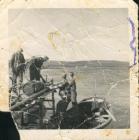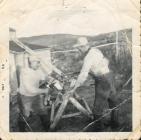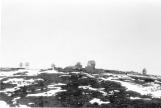14
Werner Lam, the contributor of most of our photos, gets to work shoveling snow or playing around. Note behind him...someone on a sled.18
When the Americans came to town, Fox Harbour (St. Lewis, it is called today) was very isolated, with only boats for travel in summer and dogteam for travel in winter. Every household had them. They were used to travel, bring water and firewood, and for racing during sport events. Dogteams were used for recreation and work. A very primitive type of travel, but it is all we had. Today, Dogteams are kept by people for racing and a way to preserve our old way of life.19
Plane in the harbour, similar to the first day they arrived.1959
St. Lewis, Newfoundland, Canada
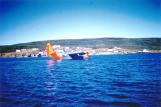 Credits:
Credits:Calvin J. Poole
20
In early June in 1954 and the weather had been fine for a week or more. Most of the snow had disappeared from the land, except for patches on the hills and stubborn drifts that remained in the valleys. The heavy arctic ice had moved offshore but numerous pieces of loose ice remained in the bay and harbour. Most of the fishermen had their motor boats and punts in the water and some were bringing their fire wood out of the bay, while they waited for the salmon fishery to start. These past few days something unusual was happening at Fox Harbour. For a week or more a large plane wouldcome and circle the harbour and then head off north again.Everyone was wondering what was goingon as the sight of a plane landed one afternoon, in the bay and taxied to the mouth of the harbour. This caused some excitement and commotion and soon there were boats heading out to the plane to see what was up.The plane appeared large, with twin engines, pontoons down from each wing and it sat heavy in the water. The boats soon returned with large packages and strange men. They landed at my grnadfather, Arthur Poole's, wharf on Fox Harbour Point and the mystery was soon over as it was learned that the Americans had arrived and they were in to survey Fox Harbour Hill for some sort of Radar Site. They had been coming for a week but could not land because of the loose ice.From then on that summer the large planes landing in the harbour became a common sight as the survey work got underway. The survey crew were housed in tents by the bottom brook and begancutting lines all across the hill. That fall the ships started to arrive and prefab buildings were set up at the camp site as the construction was started. Most of the men of the community went to work on the construction that fall and for the next couple of summers there was very little fishing from the community. the fishermen liked the good wages paid by Drake Merritt, the contractor, all in American currency. I remember after a year or so it was odd to see a Canadian dollar. One of the unforgettable things that I remember was seeing a large tractor being driven down from a ship on planks onto a barge. It was soon landed and construction of a road around the bottom of the harbour began.These were quite exciting times for young boys and we spent many hours up around the "Camps" as we called them. Once the site was constructed, the Corps of Engineers moved in and erected the dome on the tower and two large antenna dishes, then folowed the American servicemen. The site was part of the Pine Tree Radar defence line and alos a weather station. I remember going to the great Christmas parties on the site and also to the weekly movies. It brought many new things to the community. One spring part of the American Air Force Brass Band arrived at the site and the whole community was invited up to the concert. Can you imagine a brass band playing in Fox Harbour in the late 1950's? Yes, it happened. During the summer large supply ships would come and barges containing trucks would float out of the stern of these ships, then come ashore and truck their supplies up the hill to the Site. During the winter the site was serviced by helicopter and these large twin bladed machines would always come in twos.
What did this do to the community? It brought it into the Twentieth Century, it brought cash, good jobs for a short while and an end to the isolation. However the site was short lived as technology was advancing in great strides and soon the site was obsolete and closed during the early 1960's, but it put Fox Harbour on the map!
21
Kids from Fox Hr. Point pose for a rare photo1958
St. Lewis, Newfoundland, Canada
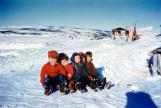 Credits:
Credits:Jody Poole
22
From the very beginning there was a great deal of involvement between the men and the residents. The men were taught many of our traditions, were shown good fishing and hunting areas, etc. The Americans introduced the community to many perks that were just not found in 1950's Labrador. They showed movies to the public every Sunday, and a ride was provided in one of the large vehicles, which was an adventure in itself. There were great Christmas parties and gifts for all every year and pop for everyone. The food on display was the likes never seen by the community who mostly lived off the land and sea.23
Kids at Fox Harbour Point pose for a photo in the woods near home1959
St. Lewis, Newfoundland, Canada
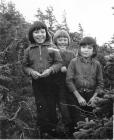
24
Kids watching the arrival of their friends from the site and pose for a photo through the window1959
St. Lewis, Newfoundland, Canada
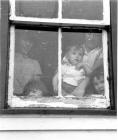
25
Another odd looking aircraft, visiting the site. What the people must have thought?1959
St. Lewis, Newfoundland, Canada
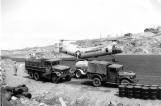
27
Movie Time at the Site1958
St. Lewis, Newfoundland, Canada
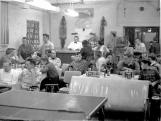 Credits:
Credits:Robert Blackburn, USAF Ret. T/Sgt.
